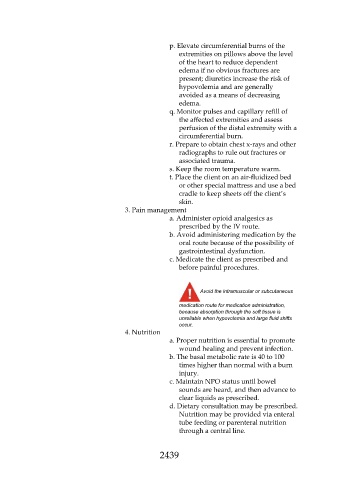Page 2439 - Saunders Comprehensive Review For NCLEX-RN
P. 2439
p. Elevate circumferential burns of the
extremities on pillows above the level
of the heart to reduce dependent
edema if no obvious fractures are
present; diuretics increase the risk of
hypovolemia and are generally
avoided as a means of decreasing
edema.
q. Monitor pulses and capillary refill of
the affected extremities and assess
perfusion of the distal extremity with a
circumferential burn.
r. Prepare to obtain chest x-rays and other
radiographs to rule out fractures or
associated trauma.
s. Keep the room temperature warm.
t. Place the client on an air-fluidized bed
or other special mattress and use a bed
cradle to keep sheets off the client’s
skin.
3. Pain management
a. Administer opioid analgesics as
prescribed by the IV route.
b. Avoid administering medication by the
oral route because of the possibility of
gastrointestinal dysfunction.
c. Medicate the client as prescribed and
before painful procedures.
Avoid the intramuscular or subcutaneous
medication route for medication administration,
because absorption through the soft tissue is
unreliable when hypovolemia and large fluid shifts
occur.
4. Nutrition
a. Proper nutrition is essential to promote
wound healing and prevent infection.
b. The basal metabolic rate is 40 to 100
times higher than normal with a burn
injury.
c. Maintain NPO status until bowel
sounds are heard, and then advance to
clear liquids as prescribed.
d. Dietary consultation may be prescribed.
Nutrition may be provided via enteral
tube feeding or parenteral nutrition
through a central line.
2439

